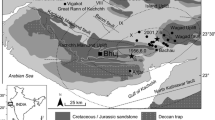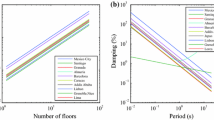Abstract
Bangladesh is a moderately seismically active region in the world. The 1897 Great Indian earthquake has caused about 1542 death and immense damage of properties. This earthquake has been located close to the main cities of Bangladesh. Poor earthquake awareness and inadequate construction practices are the main reasons for such destruction. An improvement in understanding and familiarity of seismic hazard is needed to alleviate damage due to an earthquake. Natural principal ground frequencies have been studied for the capital city Dhaka, Bangladesh using ambient vibrations. The principal frequency at 105 sites has been estimated through applying horizontal-to-vertical spectral ratio technique. The ambient vibration has been carried out for 30 min at each location. The sampling rate is 200 samples/s. The predicted principal frequency has been authenticated with earthquake data recorded at three accelerometer locations in the study area. It has been found that geological time period has a major effect on principal frequency of the ground. The obtained principal frequencies differ from 0.4 to 1.6 Hz for the fairly loose/soft Alluvium Valley Fill, Artificial Fill, and Holocene Alluvium, and for most of the Pleistocene deposit. The results imply that frequencies of different locations of the city confirm the site properties that can be proposed for studying the seismic risks to develop a plan for disaster risk reduction for the city.
Similar content being viewed by others
References
Ambraseys, N., & Douglas, N. (2004). Magnitude calibration of north Indian earthquakes. Geophysical Journal International,159, 165–206.
Ansary, M. A., & Meguro, K. (2003). Economic consequences of large earthquakes for Dhaka, Bangladesh. Bulletin of Earthquake Resistant Structure Research Center, IIS, University of Tokyo,36, 177–193.
Bangladesh National Building Codes (BNBC). (1993). Housing and Building Research Institute and Bangladesh Standards and Testing Institution, Dhaka, Bangladesh.
Bangladesh National Building Codes (Draft BNBC). (2017). Housing and Building Research Institute and Bangladesh University of Engineering & Technology, Dhaka, Bangladesh.
Bard, P.-Y., & Bouchon, M. (1985). The two-dimensional resonance of sediment-filled valleys. Bulletin of the Seismological Society of America,75, 519–541.
Bilham, R. (2008). Tom La Touche and the great Assam earthquake of 12 June 1897: Letters from the epicenter. Historical Seismologist,79(3), 426–437.
Bilham, R. (2009). The seismic future of cities. Bulletin of Earthquake Engineering,7, 839–887.
Bilham, R., & Hough, S. (2006). Future earthquakes on the Indian subcontinent: Inevitable hazard, preventable risk. South Asian Journal,12, 1–9.
Bonilla, L. F., Steidl, J. H., Lindley, G. T., Tumarkin, A. G., & Archuleta, R. J. (1997). Site amplification in the San Fernando Valley, California: Variability of site-effect estimation using the S-wave, coda, and H/V methods. Bulletin of the Seismological Society of America,87, 710–730.
Bour, M., Fouissac, D., Domonique, P., & Martin, C. (1989). On the use of microtremor recordings in seismic microzonation. Soil Dyn Earthq Eng,17(7–8), 465–474.
Castro, R. R., Mucciarelli, M., Pacor, F., & Petrungaro, C. (1997). S-wave site-response estimates using horizontal-to-vertical spectral ratios. Bulletin of the Seismological Society of America,87, 256–260.
Comprehensive Disaster Management Programme (CDMP). (2009). Seismic hazard and vulnerability assessment of Dhaka, Chittagong and Sylhet city corporation areas. Final Report. Ministry of Food and Disaster Management, Dhaka, Bangladesh.
Duval, A-M, Chatelain, J-L, Guillier, B, The SESAME WP02 Team. (2004). Influence of experimental conditions on H/V determination using ambient noise vibration method. In 13th world conference on earthquake engineering, 1–6 August, Vancouver, British Columbia, Canada.
Field, E. H., & Jacob, K. H. (1993). The theoretical response of sedimentary layers to ambient noise. Geophysical Research Letters,24, 2925–2928.
Field, E. H., & Jacob, K. H. (1995). A comparison and test of various site-response estimation techniques, including three that are not reference-site dependent. Bulletin of the Seismological Society of America,85, 1127–1143.
Horike, M., Zhao, B., & Kawase, H. (2001). Comparison of site response characteristics inferred from microtremors and earthquake shear waves. Bulletin of the Seismological Society of America,91, 1526–1536.
Kabir, M. A. (2018). Assessment of seismic vulnerability index of gas network area in Dhaka city using microtremor measurements. M.Engg. Thesis, Department of Civil Engineering, BUET, Dhaka, Bangladesh.
Koller, M. G., Chatelain, J.L., Guiller, B., Duval, A..M., Atakan, K., Lacave, C., Bard, P.Y., The SESAME Participants. (2004). Practical user guideline and software for the implementation of the H/V ratio technique on ambient vibrations: Measuring conditions, processing method and results interpretation. In Proceedings of the 13th world conference on earthquake engineering, Vancouver, BC, Canada August 1–6.
Konno, K., & Ohmachi, T. (1998). Ground-motion characteristics estimated from spectral ratio between horizontal and vertical components of microtremor. Bulletin of the Seismological Society of America,88, 228–241.
Kumar, et al. (2012). Ambient noise levels in Gujarat State (India) seismic network. Geomatics, Natural Hazards and Risk,3(4), 342–354.
Lachet, C., Hazfeld, D., Bard, P.-Y., Theodulidis, N., Papaioannou, C., & Savvaidis, A. (1996). Site effects and microzonation in the city of Thessaloniki (Greece) comparison of different approaches. Bulletin of the Seismological Society of America,86, 1692–1703.
Lermo, J., & Chavez-Garcia, F. J. (1993). Site effect evaluation using spectral ratios with only one station. Bulletin of the Seismological Society of America,83, 1574–1594.
Lizundia, B., Davidson, R. A., Hashash, Y. M. A., & Olshansky, R. (2017). Overview of the 2015 Gorkha, Nepal, Earthquake. Earthquake Spectra,33(S1), S1–S20.
Mamoon, M. (2010). Dhaka: Smiriti Bismiritir Nogori. Anannya (p. 94).
Maurin, T., & Rangin, C. (2009). Structure and kinematics of the Indo-Burmese wedge: Recent and fast growth of the outer wedge. Tectonics,28, TC2010.
Middlemiss, C. S. (1885). Report on the Bengal earthquake of July 14, 1885. Records of the Geological Survey of India,18(4), 200–221.
Morino, M., Kamal, A. S. M. M., Akhter, S. H., et al. (2014). A paleo-seismological study of the Dauki fault at Jaflong, Sylhet, Bangladesh: Historical seismic events and an attempted rupture segmentation model. Journal of Asian Earth Sciences,91, 218–226.
Morino, M., Kamal, A. S. M. M., Muslim, D., et al. (2011). Seismic event of the Dauki Fault in 16th century confirmed by trench investigation at Gabrakhari Village, Haluaghat, Mymensingh, Bangladesh. Journal of Asian Earth Sciences,42, 492–498.
Mucciarelli, M., Gallipoli, M. R., & Arcieri, M. (2003). The stability of the horizontal-to-vertical spectral ratio of triggered noise and earthquake recordings. Bulletin of the Seismological Society of America,93, 1407–1412.
Mucciarelli, M., & Monachesi, G. (1998). A quick survey of local amplifications and their correlation with the damage distribution observed during the Umbro–Marchesan (Italy) earthquake of September 26, 1997. Journal of Earthquake Engineering,2, 325–337.
Nakamura, Y. (1989). A method for dynamic characteristics estimation of subsurface using micrometers on the ground surface. Railway Technical Research Institute, Quarterly Reports,30, 25–33.
Nogoshi, M., & Igarashi, T. (1970). On the propagation characteristics of microtremors. Journal of the Seismological Society of Japan,23, 264–280.
Oldham, R. D. (1899). Report of the great Indian earthquake of 12th June 1897. Memoirs of the Geological Survey of India, 29.
Pando, M., Cano, L., Suarez, L. E., Ritta, R., Montejo, L. A. (2008). Comparison of site fundamental period estimates using weak-motion earthquakes and microtremors. In The 14th world conference on earthquake engineering October 12–17, 2008, Beijing, China.
Parolai, S., Bormann, P., & Milkereit, C. (2001). Assessment of the natural frequency of the sedimentary cover in the Cologne area (Germany) using noise measurements. Journal of Earthquake Engineering,5, 541–564.
Rahman, M. S. (2011). Applicability of H/V microtremor technique for site response analysis in Dhaka City. M.Sc. Engg. Thesis, Department of Civil Engineering, BUET, Dhaka, Bangladesh.
Rahman, M. Z., Kamal, A. S. M. M., & Siddiqua, S. (2018). Near-surface shear wave velocity estimation and V 30s mapping for Dhaka City, Bangladesh. Natural Hazards,92, 1687–1715. (published online on March 2018).
Rahman, M. Z., & Siddiqua, S. (2017). Evaluation of liquefaction-resistance of soils using standard penetration test, cone penetration test, and shear-wave velocity data for Dhaka, Chittagong, and Sylhet cities in Bangladesh. Environmental Earth Sciences,76, 207.
Rodriguez, H. S., & Midorikawa, S. (2003). Comparison of spectral ratio techniques for estimation of site effects using microtremor data and earthquake motions recorded at the surface and in boreholes. Journal of Earthquake Engineering and Structural Dynamics,32, 1691–1714.
Sabri, M. S. A. (2002). Earthquake intensity-attenuation relationship for Bangladesh and its neighboring region. M.Engg. Thesis, Department of Civil Engineering, BUET, Dhaka, Bangladesh.
Singh, A. P. (2015). Seismic hazard evaluation in Anjar city area of western India: Microtremor array measurement. Soil Dynamics and Earthquake Engineering,71, 143–150.
Singh, A. P., Annam, N., & Kumar, S. (2014). Assessment of predominant frequencies using ambient vibration in the Kachchh region of western India: Implications for earthquake hazards. Natural Hazards,2014(73), 1291–1309.
Singh, et al. (2017a). Microtremor study for evaluating the site response characteristics in the Surat City of western India. Natural Hazards,89(3), 1145–1166.
Singh, et al. (2017b). Characterizing surface geology, liquefaction potential and maximum intensity in the Kachchh seismic zone, Western India through microtremor analysis. BSSA,107(3), 1277–1292.
Steckler, M. S., Akhter, S. H., & Seeber, L. (2008). Collision of the Ganges–Brahmaputra Delta with the Burma Arc: Implications for earthquake hazard. Earth and Planetary Science Letters,273, 367–378. https://doi.org/10.1016/j.epsl.2008.07.009.
Sukumaran, P., Parvez, I. A., Sant, D. A., Rangarajan, G., & Krishnan, K. (2011). Profiling of late tertiary–early Quaternary surface in the lower reaches of Narmada valley using microtremors. Journal of Asian Earth Sciences,41, 325–334.
Szeliga, W., Hough, S., Martin, S., & Bilham, R. (2010a). Intensity, magnitude, location, and attenuation in India for felt earthquakes since 1762. Bulletin of the Seismological Society of America,100, 570–584.
Szeliga, W., Hough, S., Martin, S., & Bilham, R. (2010b). Intensity, magnitude, location, and attenuation in India for felt earthquakes since 1762. Bulletin of the Seismological Society of America,100, 570–584.
Wang, Y., Sieh, K., Tun, S. T., et al. (2014). Active tectonics and earthquake potential of the Myanmar region. Journal of Geophysical Research: Solid Earth,119, 3767–3822.
Yeats, R. S., Sieh, K., & Allen, C. R. (1997). The geology of earthquakes. Oxford: Oxford University Press.
Author information
Authors and Affiliations
Corresponding author
Ethics declarations
Conflict of interest
On behalf of all the authors, the corresponding author states that there is no conflict of interest.
Additional information
Publisher's Note
Springer Nature remains neutral with regard to jurisdictional claims in published maps and institutional affiliations.
Rights and permissions
About this article
Cite this article
Ansary, M.A., Arefin, M.R. Assessment of predominant frequencies in Dhaka city, Bangladesh using ambient vibration. Asian J Civ Eng 21, 91–104 (2020). https://doi.org/10.1007/s42107-019-00194-2
Received:
Accepted:
Published:
Issue Date:
DOI: https://doi.org/10.1007/s42107-019-00194-2














